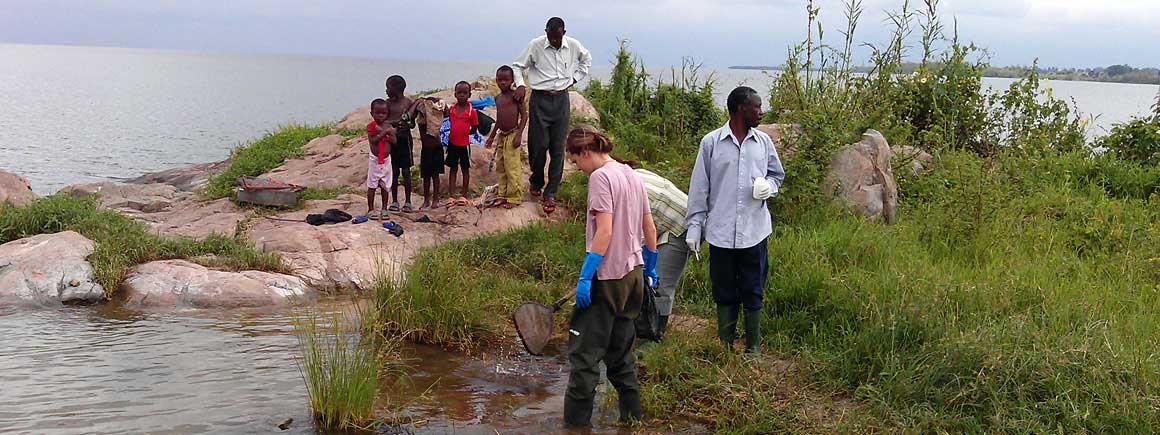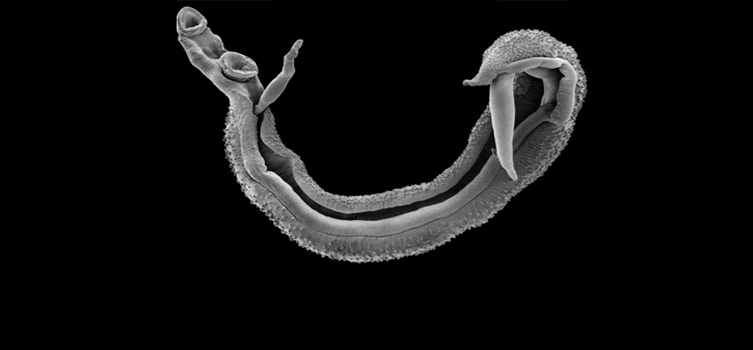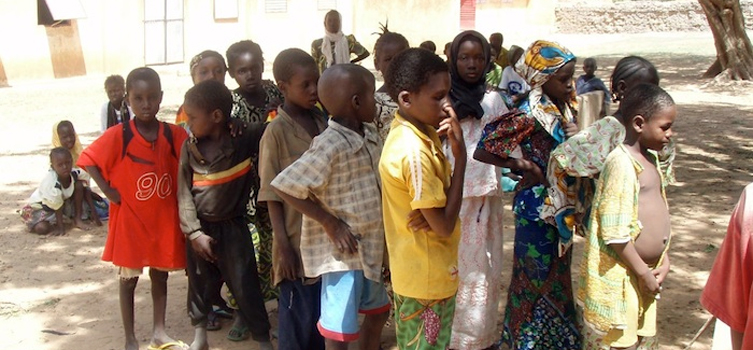Scanning for disease

Dr Anouk Gouvras and colleagues collect aquatic snails along the banks of Lake Victoria in Tanzania
In a quiet corner of the Museum’s basement, a genetic archive of parasite and snail samples is supporting ground-breaking research into schistosomiasis, a disease that affects over 250 million people worldwide.
The Schistosomiasis Collection at the Natural History Museum (SCAN) is a key resource in understanding this neglected tropical disease.
People living in more than 70 countries around the world are at risk of a disease that makes washing, bathing or swimming in natural water a real risk to their health. Also known as bilharzia, schistosomiasis is caused by parasitic flatworms (schistosomes) that live in the blood vessels of a vertebrate host. The complex life cycle of Schistosoma also involves an intermediate freshwater snail host and two larval stages.
Humans can be infected if they enter water that contains schistosomes, but communities often depend on these natural water resources for household chores, bathing and play, so they are immediately at risk. Infections may be intestinal or urinary depending on the species of schistosome, and long term infection can cause irreversible damage to vital organs.
Despite being a treatable and preventable disease, schistosomiasis affects around 250 million people worldwide and is especially prevalent in sub-Saharan Africa. It can also infect livestock, leading to economic losses for famers and the risk of transmission between animals and humans.
SCAN provides a secure and long-lasting repository of genetic schistosome material and associated ecological and epidemiological data. Combined with the Museum's molecular facilities and scientific expertise, SCAN allows researchers to advise and assist programmes aimed at controlling the disease.
Experts are using the Museum’s collection to unravel the biology and systematics of the parasites and their hosts and vectors. They hope to understand environmental and ecological aspects of the parasite’s epidemiology, monitor for genetic changes in schistosome populations and develop new diagnostic techniques for schistosome and vector species identification.
Stockpiling snails and schistosomes
Specimens are regularly added to the SCAN collection by researchers carrying out fieldwork in sub-Saharan Africa. Dr Fiona Allan, the Museum’s SCAN Project Fieldwork and Sample Manager, visits Tanzania several times a year.
Dr Allan comments:
'We are working with projects that are testing the best ways to control the disease and help treat communities affected by schistosomiasis, but we’re also there to collect specimens, which will help our research in the long term.'
The team work with local experts to collect miracidia and cercariae, larval forms of the Schistosoma parasite, and adult worm pairs living as parasites in animals. The genetic information from these samples is stored on cards that stabilise DNA at room temperature, allowing the team to safely transport genetic material back to SCAN at the Museum in London. Aquatic snails are also collected and preserved as a taxonomic record of snail diversity, as well as being used in research on disease transmission.
Foreseeing the future
Maintaining a record of parasites and hosts through time has some important long-term applications.
Dr Aidan Emery, SCAN Manager and Museum researcher, elaborates:
‘We can track the genetic diversity and structure of local parasite populations through time. That means we can monitor how the parasites may respond to various treatment strategies.’
Currently the drug praziquantel is the only treatment for schistosomiasis, so one crucial application of the collection could be monitoring for the potential spread of drug resistance genes.
Researchers have found that some species of schistosome infect both animal and human hosts, carrying the risk of zoonotic transmission - the spread of disease between animals and humans. Controlling human infection in these cases can be difficult, because the animal hosts re-infect water bodies.
Another major issue is hybridisation of schistosome species - when animal and human schistosome species interact to produce viable offspring in one definitive vertebrate host. Researchers are interested in monitoring the extent to which hybridisation occurs, how it may affect the processes of transmission and its impact on control measures.
Global genome repository
The SCAN team ensure that specimens entering the collection are preserved in the best manner possible, with all data and contextual information intact.
Dr Emery explains:
‘It’s impossible to say how molecular techniques may advance in the future. Implementing strict collections management principles now, safeguards the collections for the future, when samples may be given new value.’
For now, SCAN’s online catalogue lists specimens held in the collection, so researchers from around the world can find out what is ‘in stock’ and request access for a range of research projects, from PhD theses to global collaborations.
The Museum is designated a World Health Organisation (WHO) collaborating centre for the identification and characterisation of schistosomes and their snail hosts. The team uses their unique expertise to support endemic research institutes by training aspiring local biomedical researchers, enabling them to assist with national disease control programmes.
Wellcome support for SCAN
The SCAN collection supports numerous projects that aim to reach a target set by the London Declaration on Neglected Tropical Diseases in 2012: to bring schistosomiasis under control by 2020-2025.
In recognition of their pivotal role in reaching that goal, the SCAN team have been awarded a Wellcome Trust grant that will fund their work for a further five years. This will allow them to continue to collect, maintain and share specimens and resources, acting as the link between laboratory researchers and field teams in the fight against schistosomiasis.
Schistosomiasis: the facts
Schistosomiasis researchers
Publications
Emery, A.M., Allan, F., Rabone, M., Rollinson, D., 2012. Schistosomiasis Collection at NHM (SCAN). Parasites & Vectors 5: 185.
Knopp S, Person B, Ame S M, Mohammed K A, Ali S M, Khamis I S, Rabone M, Allan F, Gouvras A, Blair L, Fenwick A, Utzinger J and Rollinson D (2013) Elimination of Schistosomiasis Transmission in Zanzibar: Baseline Findings before the Onset of a Randomized Intervention Trial. PLoS Neglected Tropical Diseases 7, e2474.
Webster B L, Emery A M, Webster J P, Gouvras A, Garba A, Diaw O, Seye M M, Tchuente L A T, Simoonga C, Mwanga J, Lange C, Kariuki C, Mohammed K A, Stothard J R and Rollinson D (2012) Genetic Diversity within Schistosoma haematobium: DNA Barcoding Reveals Two Distinct Groups. Plos Neglected Tropical Diseases 6, e1882.
Related information
- VIDEO: Detective work to tackle debilitating disease in Zanzibar
- SCAN
- SCAN catalogue
- Molecular labs
- RISEAL Niger
- National Institute for Medical Research (NIMR) Mwanza
- London Centre for Neglected Tropical Disease Research
- The Schistosomiasis Consortium for Operational Research and Evaluation (SCORE)
- Wellcome Trust Sanger Institute
- Wellcome Trust
Superflies and parasites
Follow the Parasites and Vectors Division blog to read about our schistosomiasis research from the Museum's molecular labs to rural Tanzania.
Funded by






